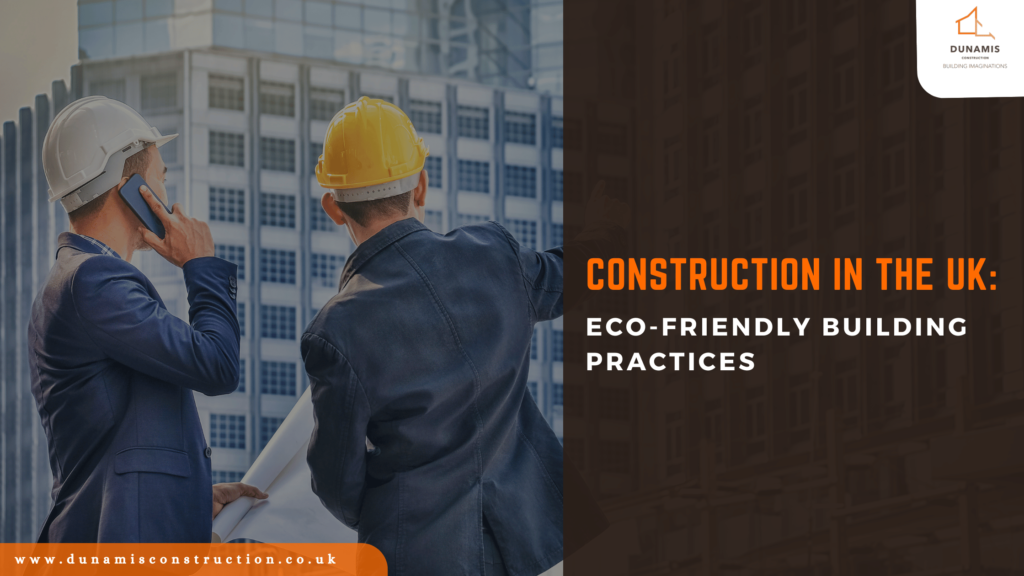The construction industry plays a vital role in shaping the UK’s urban landscape. However, it is also a significant contributor to environmental degradation, responsible for around 40% of the country’s carbon emissions. With the growing focus on sustainability, eco-friendly building practices are becoming more prominent, helping to reduce the carbon footprint and promote a greener future. In this post, we explore some of the most effective eco-friendly practices that are transforming the UK construction industry.
1. Sustainable Building Materials
One of the core components of eco-friendly construction is the use of sustainable building materials. Traditional materials like concrete and steel are notorious for their high carbon emissions during production. However, innovative alternatives such as bamboo, reclaimed wood, and recycled metal are gaining popularity. These materials are not only environmentally friendly but also durable and aesthetically pleasing.
- Bamboo: A rapidly renewable resource, bamboo is strong, lightweight, and versatile. It is ideal for flooring, scaffolding, and even structural frameworks.
- Reclaimed Wood: Salvaged from old buildings and furniture, reclaimed wood adds character and reduces the demand for new timber, preserving forests.
- Recycled Metal: Using recycled steel and aluminum minimizes the need for new raw materials and reduces energy consumption.
2. Energy-Efficient Design
Designing buildings to maximize energy efficiency is a critical aspect of sustainable construction. Energy-efficient designs help to reduce operational costs and lower carbon emissions. Here are some key strategies:
- Passive Solar Design: This involves orienting buildings to take advantage of natural sunlight for heating and lighting, reducing the need for artificial energy sources.
- High-Performance Insulation: Proper insulation helps maintain indoor temperatures, reducing the need for heating and cooling systems, which are major energy consumers.
- Energy-Efficient Windows: Double or triple-glazed windows with low-emissivity (Low-E) coatings prevent heat loss while allowing natural light to enter.
3. Water Conservation Techniques
Water is a precious resource, and its conservation is essential in eco-friendly construction. Implementing water-saving technologies not only helps the environment but also reduces operational costs.
- Rainwater Harvesting: Collecting and storing rainwater for use in irrigation, flushing toilets, and other non-potable applications reduces reliance on municipal water supplies.
- Low-Flow Fixtures: Installing low-flow faucets, showerheads, and toilets significantly decreases water usage without compromising functionality.
- Greywater Recycling: This system collects wastewater from sinks, showers, and washing machines, treating and reusing it for landscaping and irrigation.
4. Waste Reduction and Recycling
Construction projects generate a significant amount of waste, much of which ends up in landfills. Adopting waste reduction and recycling practices can mitigate this impact.
- Construction Waste Management: Developing a comprehensive waste management plan at the outset of a project ensures that materials are sorted and recycled, minimizing landfill contributions.
- Modular Construction: Prefabricating building components off-site reduces waste and allows for more precise use of materials.
- Recycling Demolition Debris: Rather than sending demolition waste to landfills, materials like concrete, brick, and metal can be recycled and reused in new construction projects.
5. Green Roofing and Landscaping
Incorporating green spaces into building design is an effective way to enhance sustainability. Green roofing and landscaping provide numerous environmental benefits.
- Green Roofs: These are covered with vegetation, providing insulation, reducing urban heat island effects, and improving air quality. They also enhance biodiversity by providing habitats for various species.
- Native Landscaping: Using native plants in landscaping reduces the need for irrigation and chemical fertilizers, promoting a healthier ecosystem.
- Permeable Pavements: Permeable materials allow rainwater to seep into the ground, reducing stormwater runoff and recharging groundwater supplies.
6. Renewable Energy Integration
Harnessing renewable energy sources is a hallmark of eco-friendly construction. Incorporating renewable energy systems into buildings reduces reliance on fossil fuels and lowers carbon emissions.
- Solar Panels: Installing photovoltaic (PV) panels on rooftops or facades generates clean electricity, reducing the building’s carbon footprint.
- Wind Turbines: Small-scale wind turbines can be integrated into building designs, especially in areas with high wind potential.
- Geothermal Systems: These systems use the earth’s natural heat to provide efficient heating and cooling solutions, reducing energy consumption.
Eco-friendly building practices are crucial for reducing the environmental impact of the UK construction industry. By embracing sustainable materials, energy-efficient designs, water conservation techniques, waste reduction, green roofing, and renewable energy integration, the industry can lead the way toward a greener future. As regulations and consumer demand for sustainability continue to rise, these practices will become even more integral to construction projects across the country.

